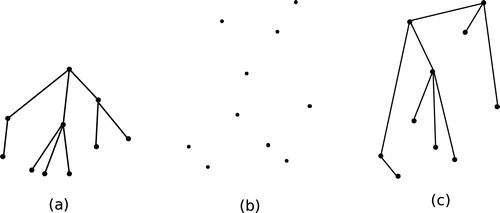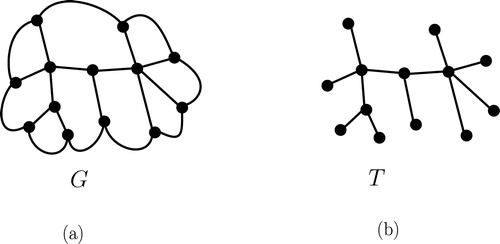 ?Mathematical formulae have been encoded as MathML and are displayed in this HTML version using MathJax in order to improve their display. Uncheck the box to turn MathJax off. This feature requires Javascript. Click on a formula to zoom.
?Mathematical formulae have been encoded as MathML and are displayed in this HTML version using MathJax in order to improve their display. Uncheck the box to turn MathJax off. This feature requires Javascript. Click on a formula to zoom.Abstract
A point set embedding of a given plane graph on a given point set
on a
plane is a drawing of
where each vertex is drawn on a point in
. An orthogonal point set embedding of a plane graph
is a point set embedding of
such that each edge is drawn as a sequence of horizontal and vertical line segments. A plane graph of the maximum degree five or more does not admit an orthogonal point set embedding. To deal with plane graphs of the maximum degree five or more, in this paper we introduce “L-shaped point set embeddings”. An L-shaped point set embedding of a plane graph
on a point set
is a point set embedding of
on
such that each edge is drawn by a sequence of two straight-line segments which create a 90° angle at their common end. In this paper we consider
-shaped point set embeddings of trees and Halin Graphs. Let
be a point set of
points on a
plane such that no two points in
lie on a horizontal or on a vertical line. We show that every tree of
vertices as well as every Halin graph of
vertices has an L-shaped point set embedding on
.
1 Introduction
A plane graph is a planar graph with a fixed planar embedding. An orthogonal drawing of a plane graph is a drawing of
such that each vertex is drawn as a point, each edge is drawn as a sequence of alternate horizontal and vertical line segments, and any two edges do not cross except at their common end. Orthogonal drawings of plane graphs have been extensively studied in literature due to their practical applications in circuit schematics, VLSI layouts, aesthetic layout of diagrams and computational geometry Citation[1–5].
A point set embedding of a given plane graph on a given point set
is a drawing of
where each vertex is drawn on a point in
. (c) illustrates an example of a point set embedding of the tree shown in (a).
An orthogonal point-set embedding of a plane graph on a set
of points on a
plane is a point set embedding of
on
such that each edge is drawn as a sequence of alternate horizontal and vertical line segments and any two edges do not cross except at their common end. Thus an orthogonal point-set embedding of a plane graph
is an orthogonal drawing of
on a given point set. Several researchers have worked on orthogonal point-set embeddings Citation[6–8]. Di Giacomo et al. Citation[6] have studied a special type of orthogonal point set embeddings which they called
-shaped point set embeddings where every edge required to be
-shaped.
-shaped point set embeddings have important practical applications in the field of VLSI layout where connectors are only allowed to be
-shaped for some specified functions. illustrates different examples of point set embeddings of graphs.
Fig. 2 (a) An orthogonal point-set embedding a graph, (b) an -shaped point set embedding of a tree and (c) an
-shaped point set embedding for high degree plane graph.
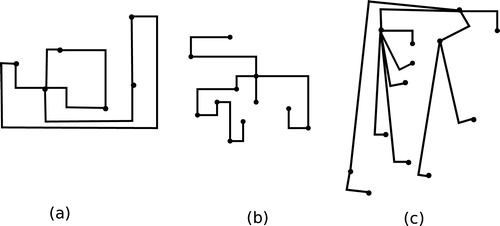
Di Giacomo et al. Citation[6] have shown that every tree of vertices and maximum degree four has
-shaped point set embeddings on a diagonal point set of
points and on a 1-spaced point set of
points where 1-spaced point set is defined as a point set on a grid such that the horizontal and vertical distance of any two points is at least 1. They have also shown that every caterpillar of
vertices and maximum degree four has an
-shaped point set embedding on 1-spaced point set of
points. Kano and Suzuki Citation[7] have studied the problem of
-shaped point set embeddings on points in general position and have shown that every tree of
vertices and maximum degree three with the property that all the vertices of degree 3 are contained in a path has an
-shaped point set embedding on a point set of
points in general position.
In this paper we generalize -shaped point set embeddings for high degree plane graphs where each edge is drawn by a sequence of two straight-line segments which create a90° angle at their common end. Note that the definition of
-shape in our case is different from the definition
-shape used in previous works. The two straight-line segments which constitute the
-shape are not necessity horizontal and vertical in our case (see (c)). We show that every tree of
vertices as well as every Halin graph of
vertices admits plane
-shaped point set embeddings on a
point set
of
points such that no two points in
lie on a horizontal or on a vertical line. An
-shaped point set embedding of a high degree plane graph may find its applications in implementing circuits with prefabricated active devices and
-shaped connectors having variable arm lengths.
The remaining of the paper is organized as follows. Section 2 presents some definitions. Section 3 gives an algorithm that admits an -shaped point set embedding of a tree. Section 4 gives an algorithm that admits an
-shaped point set embedding of a Halin graph. Finally, Section 5 contains concluding remarks and directions for further research in this field.
2 Preliminaries
In this section we present some terminologies and definitions which will be used throughout the paper. For the graph theoretic definitions which have not been described here, see Citation[1,9].
A graph is planar if it can be embedded in the plane without edge crossing except at the vertices where the edges are incident. A plane graph is a planar graph with a fixed planar embedding. A plane graph divides the plane into connected regions called faces. The unbounded region is called the outer face; the other faces are called inner faces. The cycle that lies on the outer face is called outer cycle. The edges in the outer cycle are called outer edges.
A Halin graph is a connected planar graph that consists of an unrooted tree and a cycle connecting the leaves of the tree. A Halin graph is constructed as follows. Let be a tree with more than three vertices embedded in the plane. Then a Halin graph is constructed by adding to
a cycle through each of its leaves, such that the augmented graph remains planar. We call
the core tree of the Halin graph. (a) shows a Halin graph and (b) shows the core tree of the Halin graph.
The center of a tree is either a single node or an edge, which is obtained by repeatedly deleting all the nodes of degree one, until a single node or an edge is left. The distance between two vertices of a tree is the length (in edges) of the shortest path between these vertices. The diameter is the longest path between two nodes in a tree. The length of path between two nodes is represented by the number of edges between them.
Let be an ordered rooted tree with root
whose children are ordered from left to right. Let
be the children of
and
are the subtrees at rooted
, respectively ordered in this way from left to right in
. For a vertex
of
, we denote by
the number of vertices in the subtree rooted at
.
3 
 -shaped point set embeddings of trees
-shaped point set embeddings of trees
In this section we show that any tree of vertices admits a plane
-shaped point set embedding whose vertices are given points in the plane, no two of which lie on the same horizontal or vertical line as in the following theorem.
Theorem 1
Let be a tree and let
be a set of points where no two points lie on the same horizontal or vertical line. Then every
admits an
-shaped point set embedding on
.
Proof
We give a constructive proof as follows. Let be a tree and let
be a set of points where no two points lie on the same horizontal or vertical line. We first make
an ordered rooted tree by taking an arbitrary node as the root of
and ordering the children of each vertex in a counter clockwise order which reflects the plane embedding of
. We now label each node
of
by number
of vertices in the subtree rooted at
. We next place root
to the topmost point
of
. Let
be the children of
and
are the subtrees at rooted
, respectively ordered in this way from left to right in
. We then partition the points of
into vertical strips
from leftside such that
, contains
vertices, as illustrated in (c).
Let be the topmost point of
, respectively. We now connect
to each of
by an
-shaped edge as follows. We consider the distance between these two points as the diameter of a circle and connect two points by two line segments which touch at circumference of the circle. Thus the angle at the common end of the two straight-line segments is 90°.
If of
is situated at left from
then we draw the
-shaped edge at left side of
and if
of
is situated at right from
then we draw the
-shaped edge at right side of
as illustrated in (d). We recursively draw the remaining edges. One can observe that the resulting
-shaped point set embedding is a tree as illustrated in (e).
Since we make an ordered rooted tree, find ordering of the children, place every node of the tree on the fixed point according to ordering and no two points lie on the same horizontal or vertical line, there is no possibility to cross among the
-shaped edges. □
Fig. 4 (a) A tree, (b) a point set, (c) partitioned vertical strips , (d)
-shaped edges among
to
and (e) an
-shaped point set embedding of the tree.
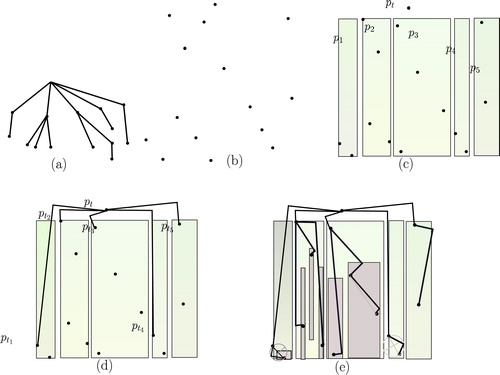
We call the algorithm described in the proof of Theorem 1 for finding -shaped point set embeddings of trees Algorithm
-shaped_Draw_Tree. One can implement Algorithm
-shaped_Draw_Tree as follows. Using bottom-up computation on the tree, one can compute the labels of each vertex of the tree in
time. First construct a linked list of points sorted according to their
-coordinates in
time and find the point
with the highest
-coordinate and remove it from the linked list in
time. The sorted linked list can be partitioned into sorted linked list for the points in
in
time. The points
can be found for
, respectively in
time. If the height of the tree is
, overall time complexity of the algorithm is
. Note that the height of the tree is at most the diameter
of the tree (and the height can be
if a center vertex of the tree is chosen as the root). Thus the following theorem holds.
Theorem 2
Let be a tree and let
be a set of points where no two points lie on the same horizontal or vertical line. Then Algorithm
-shaped_Draw_Tree finds an
-shaped point set embedding of
on
in
time, where
is the diameter of the tree.
4 
 -shaped point set embeddings of Halin graphs
-shaped point set embeddings of Halin graphs
In this section we show that any Halin graph of vertices admits a plane
-shaped point set embedding whose vertices are given points in the plane, no two of which lie on the same horizontal or vertical line as in the following theorem.
Theorem 3
Let be a Halin graph and let
be a set of points where no two points lie on the same horizontal or vertical line. Then
admits an
-shaped point set embedding on
and such an embedding can be found in
time where
is the diameter of the core tree.
Proof
Let be a Halin graph with the core tree
. We make
an ordered rooted tree by taking an arbitrary leaf as the root of
and ordering the children of each vertex in a counter clockwise order which reflects the plane embedding of
as shown in (c). Let
be a set of points where no two points lie on the same horizontal or vertical line. We then connect the edges of
by
-shaped edges according to the
-shaped point set embedding of
mentioned in Theorem 1. One can observe that the resulting
-shaped point set embedding is a tree that corresponds to the ordered rooted tree
as illustrated in (d).
We are now going to connect the outer edges of Halin graph. Since the points corresponding to vertices of the outer edges are on the points which are at outer side of each vertical strip, we can easily connect two points by -shaped edges. One can observe that the resulting
-shaped point set embedding is a Halin graph as illustrated in (e).
Since we found -shaped point set embedding of a tree in
time where
is the diameter of the tree according to Theorem 2, the overall time complexity is
where
is the diameter of the core tree.□
Fig. 5 (a) A Halin graph , (b) a point set and (c) an ordered rooted tree
and (d) an
-shaped point set embedding of
and (e) an
-shaped point set embedding of
.
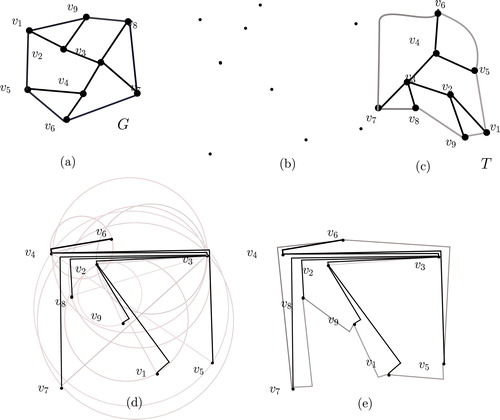
A straight-line point set embedding of a plane graph on a point set
is a point set embedding of
on
such that each edge of
is drawn as a straight line segment without any bend. It is known that a tree and an outerplanar graph have straight-line point set embeddings Citation[10,11]. If we get a straight-line point set embedding of a plane graph then we can draw the
-shaped point set embedding of that graph. We have the following theorem.
Theorem 4
Let be a plane graph and let
be a set of points. If
has a straight-line point set embedding on
then
admits an
-shaped point set embedding on
.
Proof
Let be a plane graph and
be the points of
. Let
be a straight-line point set embedding of
. We convert the straight line segment into a rectangle with
width in
as illustrated in (b). In this area we draw an
-shaped edge instead of each straight line segment as illustrated in (c). Hence the resultant embedding is a plane
-shaped point set embedding on
.
Fig. 6 (a) A graph, (b) the straight line segment is converted into a rectangle with width in
and (c)
-shaped edges instead of each straight line segment in
.

By using the algorithm described in the proof of Theorem 4 we get an -shaped point set embedding where the ratio of lengths of the two line segments of an
-shaped edge is not pleasant. But we may get useful
-shaped point set embeddings of trees and Halin Graphs by using the algorithm described in the proofs of Theorems 1 and 3.
5 Conclusion
In this paper we have introduced -shaped point set embeddings to deal with plane graphs. We have shown that every tree of
vertices admits an
-shaped point set embedding on
where
is a point set on a
plane such that no two points in
lie on a horizontal or on a vertical line and such an embedding can be found in
time where
is the diameter of the tree. We also have shown that every Halin graph of
vertices has an
-shaped point set embedding on
and such an embedding can also be found in
time where
is the diameter of the core tree.
Our research opens following problems.
| 1. | Provide an algorithm that computes | ||||
| 2. | Decide whether a plane graph | ||||
| 3. | Decide whether there exists an embedding | ||||
References
- BattistaG.D.EadesP.TamassiaR.TollisI.G., Graph Drawing: Algorithms for the Visualization of Graphs1999Prentice-Hall
- RahmanM.S.NakanoS.-i.NishizekiT., A linear algorithm for optimal orthogonal drawings of triconnected cubic plane graphs Proc. of GD 1997Lect. Notes in Computer Science vol. 13531997Springer
- RahmanM.S.EgiN.NishizekiT., No-bend orthogonal drawings of subdivisions of planar triconnected cubic graphs Proc. of GD 2003Lect. Notes in Computer Science vol. 29122004Springer387–392
- RahmanM.S.NishizekiT.NazninM., Orthogonal drawings of plane graphs without bends J. Graph Algortihms Appl. 7 4 2003 335–362
- TamassiaR.TollisI.G.VitterJ.S., Lower bounds for planar orthogonal drawings of graphs Inform. Process. Lett. 39 1 1991 35–40
- GiacomoE.D.FratiF.FulekR.GrilliL.KrugM., Orthogeodesic point-set embedding of trees Comput. Geom. 46 8 2013 929–944
- KanoM.SuzukiK., Geometric graphs in the plane lattice Proc. of EGC 2011Lect. Notes in Computer Science vol. 75792012Springer274–281
- KhanN.KarimaN.RahmanM.S.HossainM.I., Orthogonal grid pointset embeddings of maximal outerplanar graphs Proc. of ICEEICT2014IEEE1–6
- NishizekiT.RahmanM.S., Planar graph drawing Lecture Notes Series on Computing2004
- BoseP.McAllisterM.SnoeyinkJ., Optimal algorithms to embed trees in a point set J. Graph Algorithms Appl. 1 2 1997 1–15
- BoseP., On embedding an outer-planar graph in a point set Comput. Geom. : Theory Appl. 23 3 2002 303–312

